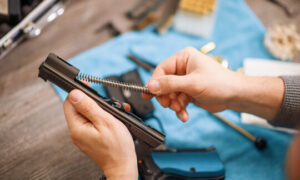When most people think about gun refinishing, they picture a shiny blued barrel or a sleek, newly polished stock. While it’s true that refinishing can breathe new life into a worn firearm, there’s far more to the process than cosmetics. Whether you’re a collector, a hunter, or simply someone who appreciates well-maintained tools, understanding the ins and outs of refinishing can help you make informed decisions — and avoid some costly mistakes.
What Exactly is Gun Refinishing?
In simple terms, refinishing is the process of restoring or altering the exterior surfaces of a firearm. This can include:
- Metal refinishing– such as bluing, parkerizing, cerakoting, or anodizing.
- Stock refinishing– sanding, staining, oiling, or replacing wooden or polymer stocks.
- Protective coating– applying finishes that help resist rust, wear, and environmental damage.
While it might sound like a purely cosmetic upgrade, refinishing also serves a functional purpose: extending the life of your firearm and preserving its value.
Little-Known Facts About Gun Refinishing
- Bluing Isn’t Actually Blue
Despite its name, “bluing” isn’t truly blue — it’s a form of controlled rusting that produces a deep, almost black finish with a subtle blue hue under certain lighting. It works by creating a magnetite layer (Fe₃O₄) on the steel’s surface, which is more stable than red rust and helps protect the underlying metal.
- Refinishing Can Lower Value — or Raise It
Collectors beware: refinishing an antique or historically significant firearm can actually decrease its value. Original patina and wear tell a story that’s important to collectors. However, for modern or working guns, refinishing can increase resale value by restoring its appearance and protecting it from further damage.
- Parkerizing Was Born in Wartime
The parkerized finish, common on military surplus firearms, was developed for durability in harsh conditions. Adopted widely during WWII, it resists corrosion far better than traditional bluing — a reason many military rifles from that era still look serviceable today.
- Some Refinishes Are Tougher Than Your Car’s Paint
Modern ceramic-based coatings, like Cerakote, can withstand extreme heat, chemicals, and abrasion. In testing, Cerakote has been shown to be more durable than automotive paint and even some industrial coatings, making it a popular choice for tactical and hunting firearms exposed to the elements.
- Wood Isn’t Always Wood
That beautiful walnut stock you’re refinishing? It might not be solid wood. Many mass-produced rifles and shotguns use laminated wood, which is layers of thin wood glued under pressure. This material can be more resistant to warping but requires different sanding and sealing techniques to avoid damaging the layers.
- Over-Polishing Can Ruin a Gun
When refinishing metal parts, aggressive polishing can remove sharp edges, lettering, or even proof marks. This not only affects value but can alter the firearm’s fit and function. Skilled gunsmiths use controlled polishing to preserve crisp lines.
- Your Granddad’s Gun Oil Might Be Hurting the Finish
Old-style petroleum-based gun oils can sometimes discolor certain finishes over time. Modern synthetic lubricants are designed to work with today’s protective coatings, preventing both corrosion and chemical damage.
When to Consider Refinishing
You might consider refinishing if:
- Your firearm shows significant surface rust or pitting.
- You want to change the finish type for better corrosion resistance.
- You’ve restored the mechanics of a gun and want the outside to match.
- You’re repurposing an older firearm for regular use.
However, if you own a collectible piece, consult a qualified appraiser before altering it.
The Bottom Line
Gun refinishing is a blend of science, craftsmanship, and respect for the firearm’s history. Done right, it can make a well-loved gun look and function like new — or even better than new. Done wrong, it can erase decades of history or damage delicate components. Whether you’re looking to preserve Grandpa’s hunting rifle or give your competition pistol a tactical edge, the key is choosing the right finish, the right process, and the right professional for the job.






























